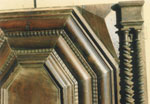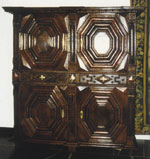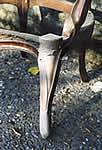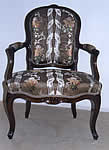
Wood is a living material that reacts to changes of temperature and humidity. Therefore it is not seldom that panels shrink, splits appear, warping and joins break.Furthermore wax or painting getting dirty often hide a nice patina, it means the natural colour acquired with age.
| Causes: |
|
Case Nr 1 : Steps of restoration of a cabinet:
1. Scouring |
 |
 |
2. Dismantling: Dismantling is imperative in all cases when the joins worked loose or when the steadiness of the furniture is concerned.This dismantling is not a huge work but the cleaning of the old lime is always indispensable. |
| 3. Grafts It is important to preserve the old piece of wood as much as possible.On the other hand, the choice of the wood to be grafted is essential to make sure that these grafts fit in the aesthetics of the furniture.L'Atelier selects old woods of the same species with a similar grain but also with a harmonized vein. 4. Finishing: It aims to protect and to give a nice appearance bringing out the vein of the wood.A 100 % natural wax, smalted on the object is spread by a vigorous rubbing to fill in the wood's pores. A woollen rag brings then the final shine. 4. Finition: ... |
 |
Case Nr 2 : Steps of restoration of a seat
French walnut cabriolet - style and period Louis XV
You expect that after restoration, your furniture can normally be used and that it withstands against an everyday use (which is not the case as far as the objects shown in a museum are concerned. The restoration must be solid without harming the appearance and the integrity of the furniture.
  |
1. Dismantling 2. Fracture or break: 3. Woodwork: |
| 4. Finishing: In order to re-nourish the wood in depth, a wax thermo polishing is absolutely requested.A 100 % natural wax, smalted on the object is spread by a vigorous rubbing to fill in the wood's pores. A woollen rag brings then the final shine 5. Upholstering: |
 |
© L'Atelier Anne-Marie FRERE s.a. 2009